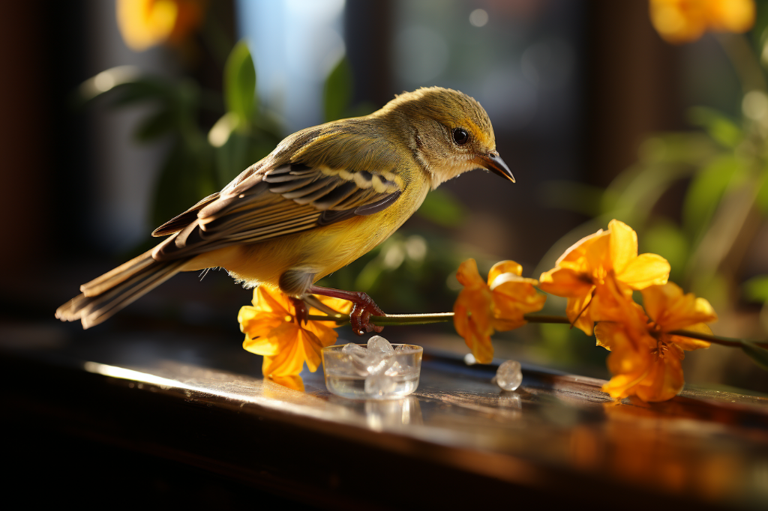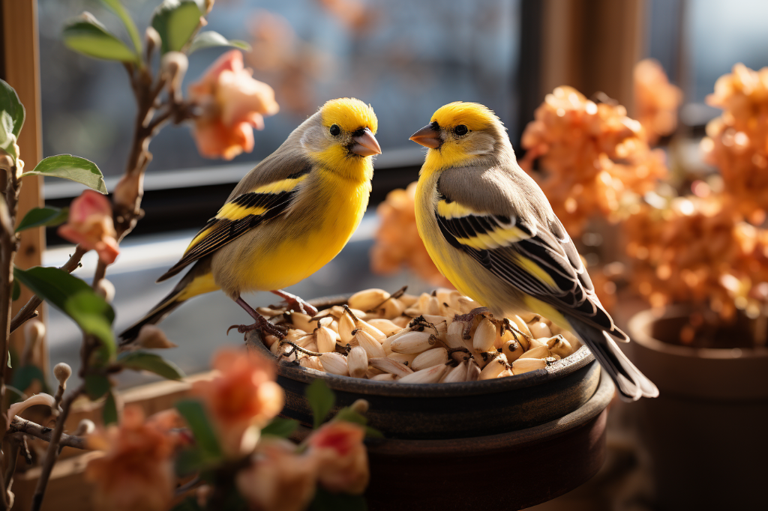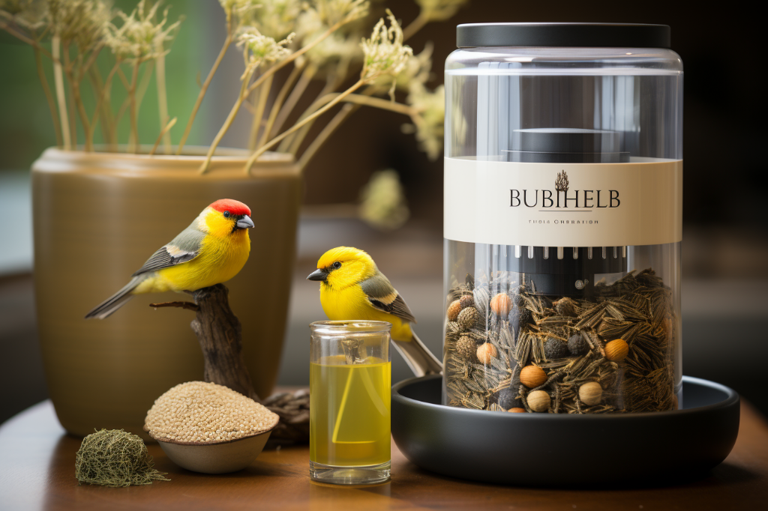Feeding Wild Birds: Ethical Concerns, Popular Practices, and Recommended Alternatives

This article discusses ethical concerns and popularity of feeding wild birds, advocating for natural habitats and proper feeder maintenance. It covers feeder types, prices, feeding guidelines, food types, the importance of native planting, and feeder positioning.
Introduction to Feeding Wild Birds
Ah, the simple, yet profound pleasure of feeding wild birds! With an estimated 59 million of my fellow Americans taking part, it’s clear that this pastime is not only popular but flourishes even more amid the disquieting times of a global pandemic. Yet we must tread lightly, curious friends, for there are ethical considerations that we ought to ponder.
The Popularity of Feeding Wild Birds
And why not, as the birds’ delightful melodies sweetly lull the morning into an enchanting awareness. Their vivid plumes hint at far off places and mystical stories untold. But there’s a certain connection, an unspoken bond that blooms as I sprinkle my preferred lyric fruit and nut wild bird seed. It’s happened with so many of us, the quiet joy it brings is irresistible.
The Ethical Considerations Involved
However, we must mindfully dwell on the potential for our well meaning actions to change bird behavior, make them easier prey, or cause those heartbreaking window collisions. There’s a risk too, that we may unwittingly contribute to the spread of diseases among the bird population. We wish to nourish, not harm these delicate, flying wonders.
Alternatives to Typical Bird Feeding
A bird friendly garden, replete with their much loved plants is likely the perfect alternative. Recreating their natural habitat, we give them the liberty to forage as they naturally would, without the risks associated with conventional bird feeding. With such a harmonious co existence, we can continue to appreciate the enchanting world of birds from the comfort of our very own backyards.
Ah, the fascinating realm of wild birds! So much to explore, so many truths to uncover, so many ways to get involved. In the tranquil dawn of a new day, let us reflect, question, and stretch our understanding, all in the beautiful pursuit of avian harmony.

Guidelines and Strains of Bird Feeding
Recognizing and adhering to the guidelines for bird feeding, as per the wisdom of the Maryland Department of Natural Resources, is not merely a suggestion it’s akin to a melodious song sung in the avian language, requesting our thoughtfulness. Be it the selection of an appropriate mix of foods or deciding the kind of feeders to use, our choices invariably affect the world of our feathery friends, wild birds inlimited.
Official guidelines for bird feeding
A symphony of colors, songs, and wings these are what I’m reminded of when I evaluate the official guidelines on feeding wild birds. Emphasizing the nourishment they need, it’s essential that we provide the right mix of seeds, nuts, and berries, following the symphony that the Maryland Department of Natural Resources plays flawlessly.
Importance of constant feeder maintenance and cleanliness
Regular cleaning and maintenance of bird feeders stand as noble custodians in warding off any diseases that might spread amongst these delicate creatures. We must make this a steady rhythm in our bird feeding routine, almost like the consistent heartbeat of a bird, vital and unvarying.
Effect on wild birds of feeding bread and table scraps
Feeding bread and other table scraps to birds might seem generous, but these might as well be silent vespers of harm. Spoiling quickly, these scraps lack the necessary nutrition, much like a barren tree in winter—it stands, but cannot provide.
As we afford our empathy and fascination for these enchanting creatures, may we remember that our choices weave direct impacts into their lives. To those that join me in my enchantment, I whisper a gentle note of reminder that our actions and decisions compose their survival and wellbeing.

Embracing the Variety: Different Types of Bird Feeders
There is a wonderful spectrum of feeders for the wild birds near me, each designed uniquely to entice certain species. We have the traditional tube feeders, a common sight in bird lover’s abodes, meant to attract the smaller varieties of bird like the chickadee or tax sparrows. Then, there are the hopper feeders, a bit more intricate with its, inviting finches, blue jays, and cardinals. And finally, the more open, free reign platform feeders catering to larger winged visitors like doves and sea gulls.
Catering to Specific Bird Species
Each of these bird feeders is a catering service specifically designed to tantalize the taste buds of distinctive bird species. For instance, the tube feeders, with their slender design and nearly weightless perch points, are a veritable ’birdie diner’ for small songbirds like sparrows, titmice, and finches. On the other hand, the larger, sturdier hopper feeders, with their size and ability to hold more feed, make an excellent choice for larger birds like grosbeaks, jays, and pigeons. The platform feeders, with their open, accessible design, are the perfect place for ground feeding birds like quail, juncos, and mourning doves to grab a quick meal.
Positioning Bird Feeders for Safety & Success
There’s no sense in setting a party if none of your guests feel comfortable enough to attend. That’s why positioning bird feeders properly is so paramount. To prevent unpleasant run ins with window glass and to deter those pesky ground predators, your bird feeders must be ideally positioned near shrubs, offering a quick escape route, or far from trees and homes to avoid ambushes. It’s a fascinating ballet of risk and reward, an enticing game of hide and seek. Bird feeder placement is an art in itself—an art that ensures the safety of our feathered friends and helps us live in harmony with them.

Types of Bird Food
Birds, much like us, prefer variety in their diet. Acknowledging this diversity in avian taste buds, let’s take a look at the banquet we can serve our feathered friends.
Variety of Seed Types and Their Uses
Seeds, the staple food in a bird’s pantry, invite an exciting range of species to your backyard. Sunflower seeds, for example, are a hot favorite amongst most, while some birds, including doves and juncos, take a particular liking to white millet. Safflower seeds, sadly ignored by squirrels, are delectable treats for cardinals. Now, how about that for avian fine dining?
Non-Seed Food Options for Birds
Moving beyond seeds, the menu extends to suet, fruits, mealworms, and even nectar. An offering of suet cake during winters works brilliantly for birds craving for fat deposits to keep warm. Citrus fruits are well appreciated by Orioles, while a plate of mealworms will, surprisingly, win you a grateful Robin nod. If the wild birds for sale catch your attention and you happen to bring a hummingbird home, remember that a feeder filled with nectar can work like a charm.
Role of Native Planting in Supplementing Bird Food
On the ’green’ side of things, native planting plays an underrated but pivotal role. Complementing these feeders, native trees, shrubs and flowers provide an additional feeding station for birds and also help camouflage them against predators. Thus, whether it’s the sunflower or the marigold in your flower bed, bear in mind that you’re not just growing plants but also cultivating a vibrant ecosystem in your own backyard.
Feeding birds looks simple, yet this array of diverse food options tells a different tale. From the seed loving Cardinal to the nectar swooning Hummingbird, understanding bird diets is, in fact, an intricate business, brimming with enchanting information awaiting exploration.
Key Takeaways
Run your fingers through a bag of lyric fruit and nut wild bird seed and ponder on the weight you bear carrying such a deceptively simple responsibility. I’ve always said our dealings with our feathered friends should echo reverence. And it begins with a keen understanding of ethical concerns.
Crucial Points about Ethical Concerns
For us, the stewards of nature, there are ethical concerns such as restricting the dependencies of wild birds unlimited by humans. We must act responsibly, aiding without causing impairment, standing as silent allies rather than interfering benefactors. Encourage independence, yes, but nurture with caution.
The Importance of Following Guidelines and Maintaining Cleanliness
Peep into a bird’s world and you’ll find they’re not so different from us. They also require a safe and clean environment. Across neighborhoods where wild birds near me, stringently following feeding guidelines and ensuring cleanliness in bird feeders are integral aspects of disease prevention. It involves regular cleanups, correct feeding amounts, and timely replenishment.
Decision-making Factors for Feeder Types and Food Options
If you delve a little deeper, you’ll find a colorful diversity of feeder types and an abundant selection of food choices, as varied as the wild birds for sale in the pet store. But we’re not trapping, we’re attracting. Pairing appropriate feeders with the right diet, supplemented by native planting, can contribute to successful bird feeding practices.
As we close our discussion, it’s poignant to consider these takeaways. For our journey across the avian spectrum is fundamentally entwined with these elements: ethical feeding, cleanliness, and careful decisions concerning feeders and food. These guiding principles are the key to providing our airborne comrades a piece of the heavens right here on earth.


